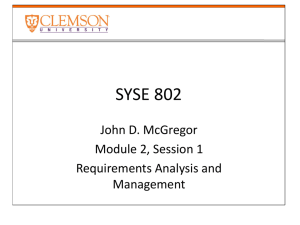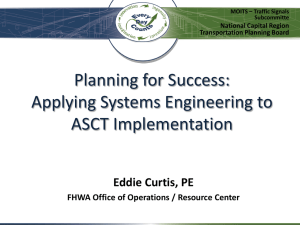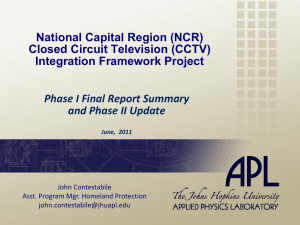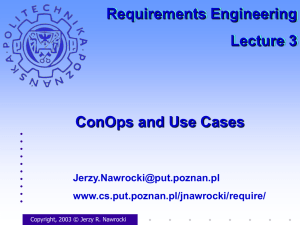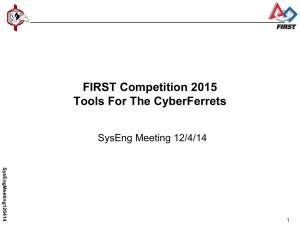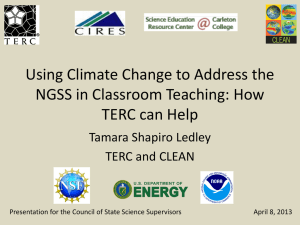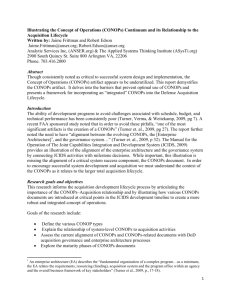ppt 1
advertisement
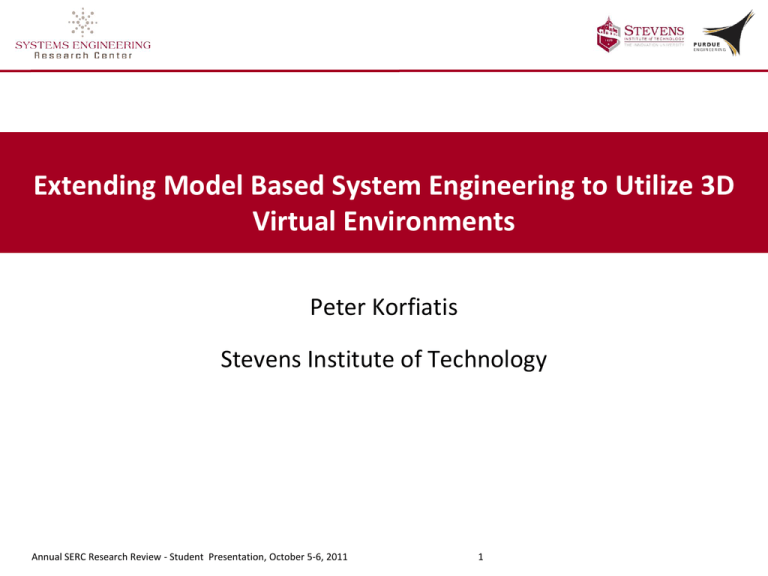
Extending Model Based System Engineering to Utilize 3D Virtual Environments Peter Korfiatis Stevens Institute of Technology Annual SERC Research Review - Student Presentation, October 5-6, 2011 1 Research Problem • There is often a disconnect between what the warfighter or analyst needs a system to do, and what developers think the system needs to do • Artifacts created during the Early Systems Engineering phase are often not referenced throughout the rest of the development lifecycle • Model Based System Engineering is advancing in certain phases of development but there is little connection between MBSE artifacts across the entire development lifecycle Annual SERC Research Review - Student Presentation, October 5-6, 2011 2 Research Need There is a need to: • quickly and graphically articulate a CONOPS for new missions and systems that will allow a diverse group of stakeholders to reach a shared mental model of the mission and potential solutions. • make the CONOPS available as a model so that the true needs of stakeholders can be conveyed to future system developers. • use model based artifacts to drive model based system architecting • allow future system developers to easily alter a CONOPS to mirror current state of the system. Annual SERC Research Review - Student Presentation, October 5-6, 2011 3 Research Questions • Can the use of a virtual environment enhance stakeholders' ability to collaborate to reach a shared mental model and to develop a model based CONOPS? • Does real-time collaboration between distributed stakeholders improve the CONOPS development? • Can a model based artifact of a CONOPS be used to drive Analysis of Alternatives and other Pre-Milestone A analysis activities? • Can the results of model based CONOPS be used by system architects to develop a system that better reflects the needs of the stakeholders. • Can an integrated model based approach to Concept Engineering and Architecture and Design be enhanced by the use of virtual environments and will this new process improve system quality? Annual SERC Research Review - Student Presentation, October 5-6, 2011 4 Sources for CONOPS Guidance • ANSI/AIAA G-043-1992 – guide from American National Standards Institute • IEEE 1362-1998 – IEEE guide for CONOPS document • DI-IPSC-81430 – DoD data item description for CONOPS document Annual SERC Research Review - Student Presentation, October 5-6, 2011 Title page Revision chart Preface Table of contents List of figures List of tables 1.Scope 1.1 Identification 1.2 Document overview 1.3 System overview 2.Referenced docum ents 3.Current system or situation 3.1 Background, objectives, and scope 3.2 Operational policies and constraints 3.3 Description of the current system or situation 3.4 Modes of operation for the current system or situation 3.5 User classes and other involve d personnel 3.6 Support environment 4.Justification for and nature of changes 4.1 Justication of changes 4.2 Description of desired changes 4.3 Priorities among changes 4.4 Changes considered but not included 5.Concepts for the proposed system 5.1 Background,objectives, and scope 5.2 Operational policies and constraints 5.3 Description of the proposed system 5.4 Modes of operation 5.5 User classes and other involved personnel 5.6 Support environment 6.Operational scenarios 7.Summary of impacts 7.1 Operational impa cts 7.2 Organizational impacts 7.3 Impacts during development 8.Analysis of the proposed system 8.1 Summary of improvements 8.2 Disadvantages and limitations 8.3 Alternatives and trade -offs considered 9.Notes Appendices Glossary 5 Model Based Systems Engineering Annual SERC Research Review - Student Presentation, October 5-6, 2011 6 Model Based System Architecting • Major advances have been made by INCOSE, OMG and other organizations to strengthen the model based approach during System Architecture and Design • The primary input to the architecting phase are the system requirements. Annual SERC Research Review - Student Presentation, October 5-6, 2011 7 Challenges with MBSA Today bdd [Package] Interactions Betw een RTs [Interactions Betw een RTs] «block» RT31 «block» RT30 CONOPS «block» CONOPS Nav igator «block» External Tool File Repository «block» Concept Engineering System «block» Primitiv e and Scenario Repository «blo... External Tool Interfaces «block» Data Transfer Architect «block» Univ ersal Data Schema «block» External Tools «block» RT23 Requirements «block» Data Transformation «block» CONOPS Lobby «block» Application Execution «block» CES - OneSAF Interface «block» OneSAF «block» 3d Modeling Tool «block» @Risk «block» SparxEA «block» Communication Effects Serv er «block» AnyLogic «block» VBS2 «block» Excel «block» GIS Data Prov ider System Architecture • Model is an abstract representation of the real world, subject to biases of the model constructor and model viewer • Requirements are passed to architects on paper or through a tool • Architects need to discern what the stakeholder needs the system to do from the requirements • Incorrect understanding of the requirements can lead to architects designing a system that does not meet the stakeholders’ needs Annual SERC Research Review - Student Presentation, October 5-6, 2011 8 Proposed Approach • An approach and toolset to allow system developers to create models at the onset of systems engineering activities that can ―Be developed directly by the end user ―Accurately reflect the needs of future users ―Be used to analyze proposed systems early in the SE lifecycle ―Easily be adapted to reflect changing requirements and design ―Automate the transfer of requirements and specifications to system architects ―Be useful throughout the SE lifecycle Assessment of current model based and visualization tools has pointed to the use of Gaming and Virtual Environments as high potential development environments Annual SERC Research Review - Student Presentation, October 5-6, 2011 9 Virtual and Gaming Environments • Virtual Immersive Environments have long been used by engineers to: ―Solve difficult problems that require 3D visualization ―Train and Educate personnel ―Analyze the impact of systems on environment and users ―Present concepts to customers Annual SERC Research Review - Student Presentation, October 5-6, 2011 10 Development Using Unity 3D • Unity is a popular IDE for creating 3D games. • Extensive support community • Cross platform deployment • Rapid deployment and testing • Interoperability of programming languages • Database and networking support • Currently being used by: ―Building Construction Architects to model buildings ―Defense contractors to develop training simulations ―Process Engineers to model complex processes ―Biologists to model complex biological behavior Annual SERC Research Review - Student Presentation, October 5-6, 2011 11 Integrated Concept Engineering System Vision Concept Engineers and Stakeholders will enter the tool through a virtual lobby. They will select their Avatar of choice. As the team comes together in the ICES Lobby, each participant will select their individual role - developer or author. CONOPS Navigator Process Manager Data Exchange Tool Tool Execution Manager The tool then provides guidance and navigation help through the process of integrating tools and developing the CONOPS. Once the team agrees on the concepts, the scenario(s) can be put into motion for observation and analysis. The scenario(s) can be modified, or stored for later sharing with others for approval Annual SERC Research Review - Student Presentation, October 5-6, 2011 12 Developing a CONOPS Using ICES act [Package] Activities [Activity Diagrams] :User :CONOPS Lobby Start CONOPS Navigator Load CONOPS Lobby Screen Choose Avatar/User Classification Set access control :CONOPS Navigator :Data File Repository :Data Transformation :Data Transfer :CONOPS Engineering System :External Tools ActivityInitial Spawn Avatar into Navigator Choose Activity to be carried out create/modiify CONOPS model transfer data between tools application execution Bring up Navigator "Bookcases" UI Create/Modify CONOPS Model Choose External Tool from "Bookshelf" FlowFinal Bring up capability selection GUI Select Tool to Import Data from Query File Repository Show File List Select Data Source File Load SourceData File Create blank Data Output FIle Specify Data Output File Choose External Tool from Bookshelf Choose File for Execution Write results to blank Output File Bring up capability selection GUI Select Tool to Execute Transform Data to fit Universal Schema Query File Repository Show File List Choose to Open External Tool Open External Tool FlowFinal FlowFinal Annual SERC Research Review - Student Presentation, October 5-6, 2011 Save oputput File with Universal Schema Save output file in desired file format Parse out useless data fields from output file 13 ActivityFinal ICES High Level Architecture bdd [Package] ICES Architecture [ICES Conceptual Architecture] RT31 Integrated Concept Engineering System @Risk Interface @Risk OneSAF Interface OneSAF 3D model importer 3D modeling tool CES - OneSAF Interface Communication Effects Server RT30 CONOPS Engineering System Primitive and Scenario Repository CONOPS Lobby CONOPS Navigator RT23 VBS2 Other External Tool Interfaces Data File Repository Universal Data Schema Annual SERC Research Review - Student Presentation, October 5-6, 2011 SparxEA Interface SparxEA Excel Interface Excel AnyLogic Interface AnyLogic Matlab Interface Matlab 14 SimuLink Current Development Efforts • Using Unity 3D, a leading game development engine, as development environment • Building interfaces between popular Early Systems Engineering analysis tools • Building an interface for CONOPS personnel • Creating MBSA artifacts to give architects an accurate representation of user needs Annual SERC Research Review - Student Presentation, October 5-6, 2011 15 Proof of Concept Prototype CONOPS Author Partial Textual CONOPS Concept Engineering System Graphical Scenario Descriptor Primitive Developer MBSA Artifacts Annual SERC Research Review - Student Presentation, October 5-6, 2011 16 Slide 16 Prototype Workshop New Agency scenarios for initial testing and feedback on CES Tool 1. Simple limited primitive scenario– run as demo 2. Extended scenario– run as demo 3. 4. Author viewpoint Developer viewpoint – create new primitives, change attributes on existing primitives Author viewpoint – import new primitives, modify existing scenario to include new primitives Multi-player (user and observer) – run as exercise User Scenario – Flexible to allow users to stretch CES – run as exercise Author Viewpoint Developer Viewpoint Gathering Metrics– run as exercise Split into teams and try to collect metrics related to OCNOPS creation with and without CES Annual SERC Research Review - Student Presentation, October 5-6, 2011 17 Future Work • Move from a limited functionality, proof of concept prototype to highly functional prototype • Build out application infrastructure • Implement Executable Scenarios • Develop CONOPS and ICES development workflow to assist users in tool use • Build primitive libraries for multiple domains relevant to sponsor’s operating environments • Automate translation of graphical CONOPS output to MBSA input Annual SERC Research Review - Student Presentation, October 5-6, 2011 18 For more information • Peter Korfiatis ―pkorfiat@stevens.edu • Dr Robert Cloutier, PI ―Robert.cloutier@stevens.edu • Stevens Visualization, Modeling and Computation Lab ―www.stevens.edu/vmc Annual SERC Research Review - Student Presentation, October 5-6, 2011 19
